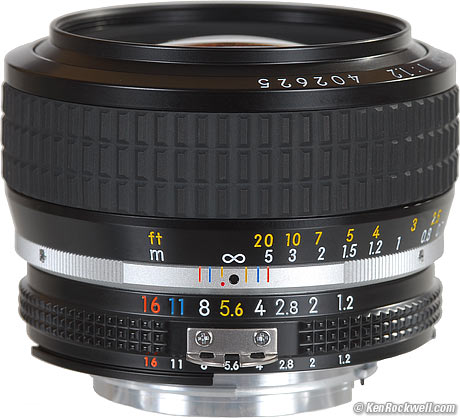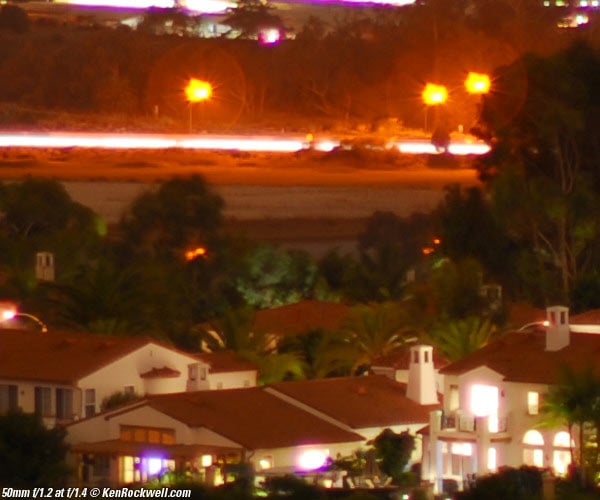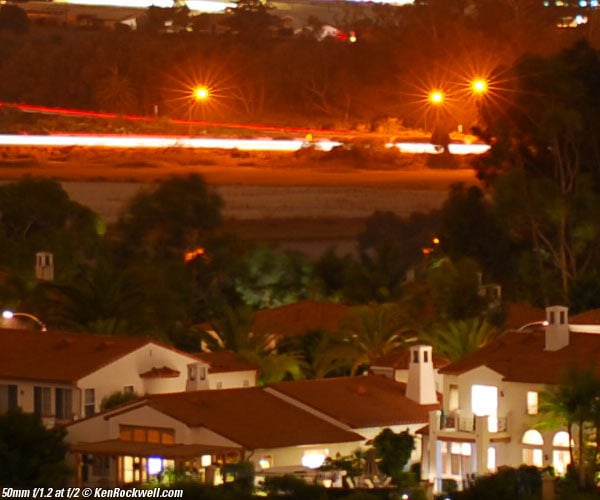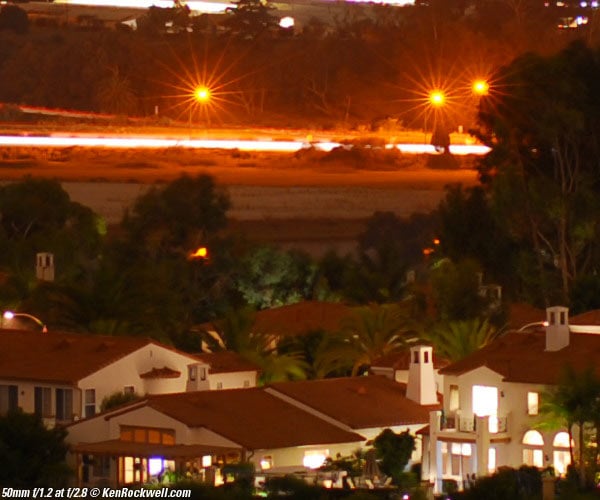Nikon
50mm f/1.2
Sharpness
© 2007 KenRockwell.com
Nikon Nikkor 50mm f/1.2 AI-s. enlarge
I bought mine brand-spanking-new at Adorama. You also can try Amazon. It helps me keep adding to this site when you get yours from these links, too.
October 2007
Return to where you were in the Nikon 50mm f/1.2 Review
Return to top of Nikon 50mm f/1.2 Review
NEW: Nikon High-Speed 50mm Lens Sharpness Comparison 09 Sep 2010
NEW: Nikon 50mm f/1.2 Coma Examples 09 September 2010
Shot at the correct aperture for conditions, the 50mm f/1.2 is among the sharpest lenses I've ever used.
I've never used a sharper lens at f/2. My 28mm f/1.4 AF is as sharp, and my other lenses aren't quite as good specifically at f/2.
Stopped down further, the 50mm f/1.2 only gets better. I would use this 50mm f/1.2 as a general purpose lens; it's great.
Like most 50mm lenses, this Nikon 50mm f/1.2 is very, very sharp. It's sharper than my zooms. Nikon warns in the instruction manual to use the 55mm f/2.8 Micro if you need the best resolution, but I love the 50mm f/1.2. Go shoot it and you'll see.
Of course it's at its worst wide-open at f/1.2, and has the expected contrast-lowering spherical aberration. Even if you're stupid enough to shoot it in broad daylight at f/1.2, it's still quite usable.
If you want better performance at f/1.2, your only other option is to drop four figures on a used 58mm Noct and take your chances (I haven't tried one yet), or get the superior Canon 50mm f/1.2 L.
Stop down to f/2 and it's great. Face it: you'll rarely be shooting this lens at larger than f/2.8 anyway, and at f/2 and f/2.8 its performance is stellar.
Most 50mm lenses perform similarly well, as does the more practical (for digital) 50mm f/1.4 AF. The surprise is how well the f/1.2 lens performs after I was presuming they were awful after all these decades.
When you get Velvia 50 transparencies back from the lab and loupe them, you suddenly realize what you were missing. This lens, like many better Nikon lenses, gives results so sharp on Velvia that they start to look 3-D. They have an etched quality that, through the industry-standard 8x Peak loupe, is better than most people's eyesight. You have to grab an unusual 22x loupe or a microscope to find fault with the images.
Center Sharpness
Warning: Only idiots shoot lenses wide open at f/1.2 in broad daylight. I'm trying to make this lens look bad.
Like other spherical f/1.4 lenses, it's sharp wide open, but with lower contrast due to all the spherical aberration. If you're silly enough to shoot at f/1.2 in daylight, this gives a slightly soft focus or dreamy effect at large magnifications.
The normal size image below looks fine, even at f/1.2 in broad daylight. This was a 1/6,000 second exposure at ISO 100.

Full Image, Nikon D200 (DX), f/1.2. (natural shadow on lower left.)
f/1.2 and f/1.4: High resolution, but lower contrast due to the hazy effects of spherical aberration. If you shoot in daylight and look closely it's a bit of a dreamy effect, and at night it helps fill in and add detail to shadows. At the size of the image above it looks fine. If you blow it up to 44" (1.1m) wide and stick your nose in it, it looks like this:
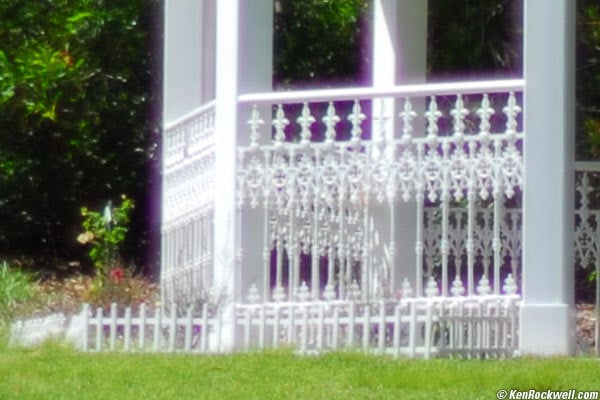
Nikon 50mm f/1.2 at f/1.2, crop from center of above image at 100%.
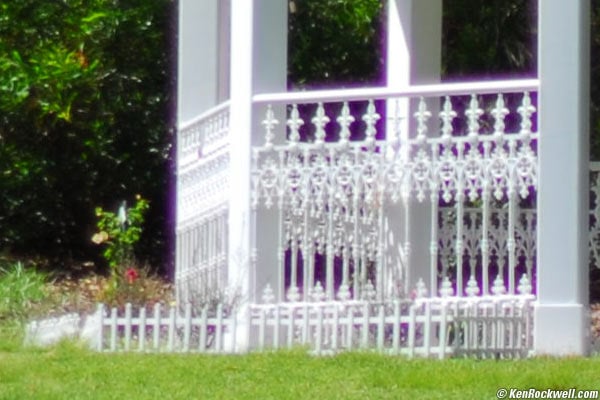
Nikon 50mm f/1.2 at f/1.4, crop from center at 100%.
f/1.4 looks about the same as f/1.2. It looks the same as the 50mm f/1.4 lenses do at f/1.4.

Nikon 50mm f/1.2 at f/2, crop from center at 100%.
This is why you get the 50mm f/1.2. At f/2, spherical aberration is gone, so it's much contrastier and sharper. There is no focus shift as I found on most 50mm f/1.4 lenses, which greatly decrease their sharpness if you're looking this closely. At f/2 the 50mm f/1.2 gives much better performance than other lenses.

Nikon 50mm f/1.2 at f/2.8, crop from center at 100%.
At f/2.8 it's just a little bit sharper and about as good as it gets.

Nikon 50mm f/1.2 at f/4, crop from center at 100%.
f/4 is just a tiny bit better than f/2.8. It gets no sharper with any further stopping down.
As you can see, you get just about optimum performance from f/2 on. Other lenses don't give optimum performance as wide as f/2. The 58mm f/1.2 NOCT aspherical had better give better performance at f/1.2, which would be the only reason to buy it.
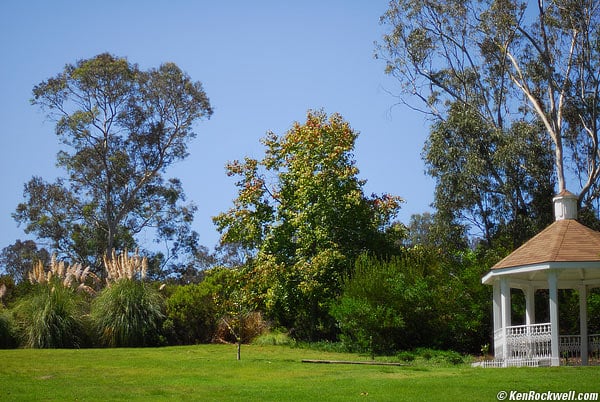
Nikon 50mm f/1.2 at f/1.2, complete image, Nikon D200 (DX).
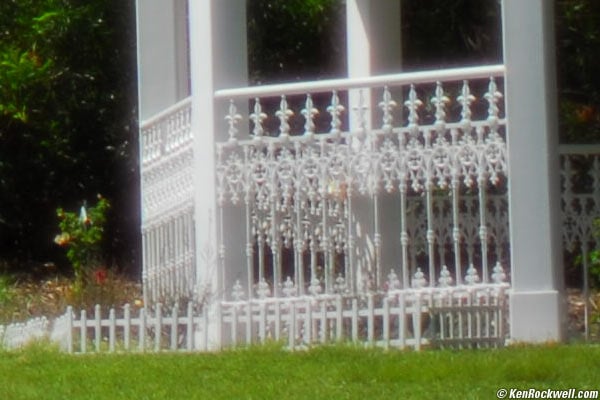
Nikon 50mm f/1.2 at f/1.2, crop from corner at 100%.
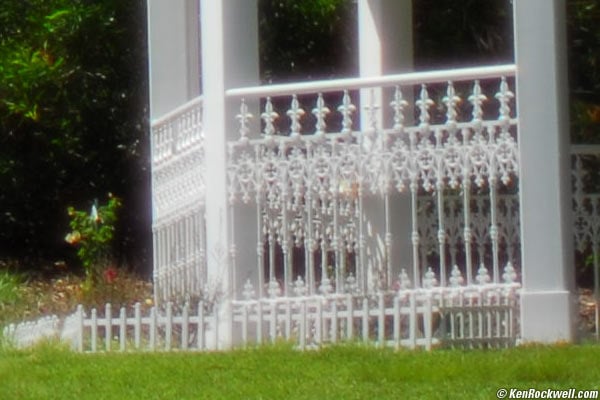
Nikon 50mm f/1.2 at f/1.4, crop from corner at 100%.

Nikon 50mm f/1.2 at f/2, crop from corner at 100%.

Nikon 50mm f/1.2 at f/2.8, crop from corner at 100%.
There isn't any difference as the apertures get smaller. Diffraction eventually takes over.
I don't see any difference between this 50mm f/1.2 AI-s and the 50mm f/1.4 AI in real shooting, but now that I've formatted these comparison shots as greatly enlarged rollovers, it's more obvious than it ever was in real photography.
Here is a complete guide image from my D200 (DX) at ISO 100:
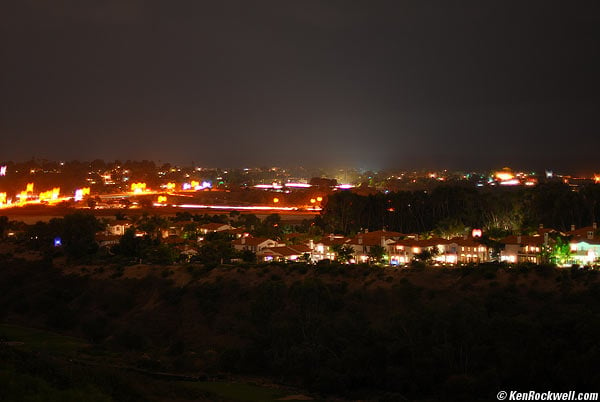
Complete reference image, Nikon 50mm f/1.2 at f/1.2, 6 seconds.
Here is a crop from the above image at 100%. If you printed the entire image at this same magnification, you'd have a 44" (1.1m) wide print.
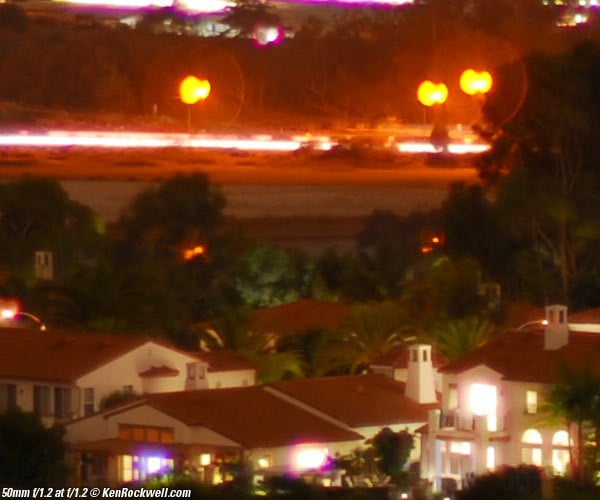
Nikon 50mm f/1.2 at f/1.2, crop at 100%.
The blobs around the lights are spherical aberration. If I showed the corners, these would transmogrify into weird shapes called coma, which you can see at the sides of the full guide image at the top of this section.
For night shots, the 50mm f/1.2 cleans up just a tiny bit at f/1.4 (8 second exposure):
Comparison at f/1.4. (mouse-over)
Trick: Roll mouse over to compare to the same thing with the 50mm f/1.4 AI. The f/1.4 lens looks awful here in the center, but in the corners the f/1.2 had even weirder coma, so they are about even over the DX frame.
Here's the same thing at f/2:
Comparison at f/2. (mouse-over)
See how the image from the 50mm f/1.4 seems out of focus at f/2? That's focus shift due to spherical aberration., and I saw it a year ago in the f/1.4 lenses only at f/2. At f/2, the 50mm f/1.2 lens clearly is better than the 50mm f/1.4. Both these lenses were focused manually at their correctly calibrated infinity stops.
Here's the same thing at f/2.8 (15 second exposure):
Comparison at f/2.8. (mouse-over)
These differences seem huge as shown here with controlled conditions, but honestly I never noticed them as obviously until I formatted them into this page as rollovers. You'd only see them in 44" (1.1m) wide prints, and then only is you looked at the prints as closely as you're looking at this screen.
Notice the stars on the bright lights: they have 14 points from the 7-bladed diaphragm of the 50mm f/1.4 AI and 18 points from the 9-bladed diaphragm of the 50mm f/1.2 AI-s.
As I wrote this page, a Chinese 50mm f/1.4 AF-D just arrived, and might be better than my older 50mm f/1.4 AI even though they have similar optics. One fine day (or night) when my D3 arrives I'll have another shootout.
Return to where you were in the Nikon 50mm f/1.2 Review
Return to top of Nikon 50mm f/1.2 Review
PLUG
If you find this as helpful as a book you might have had to buy or a workshop you may have had to take, feel free to help me continue helping everyone.
Thanks for reading!
Ken
Caveat: The all the ads below come from third parties. I don't see them before they appear on your screen. See more at my Buying Advice page. Personally I get my goodies at Ritz (the store, not the hotel gift shop), Amazon and Adorama.




